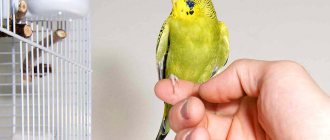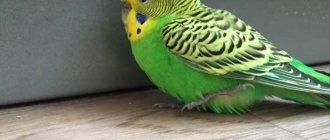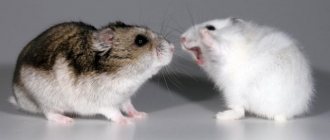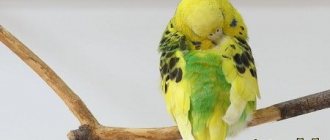Among all the sounds that pets and birds make, the cry of a parrot is one of the most unpleasant. Talking parrots bring owners a lot of positive emotions, but with their harsh voices they also cause inconvenience. Let's consider why birds may scream, how to act in a problematic situation, and whether it is possible to force a pet to lower its tone.
Why does the parrot scream
Screaming in the morning hours is normal. In nature, at sunrise, birds wake up and begin to communicate with each other. The noise made by the flock can be heard at a great distance from its location. At home, natural biorhythms are preserved.
Screams in the daytime and evening may be due to the following reasons:
- stress from moving, changing surroundings, having a new pet or family member, unusual frightening objects, change of owner, loud noises;
- attempts to drive away a stranger, cat or dog that is near the cage and scares the bird;
- attempts to establish contact with birds singing outside the window;
- feed requirement;
- boredom, jealousy of other animals or people, attracting the owner’s attention;
- requirement to be released from the cage for a walk;
- illness, discomfort.
The tendency to scream, as well as the volume of the voice, depend on the species of the pet. The loudest screamers are representatives of large species (macaws, cockatoos, Amazons, Grays). The middle-sized species also scream quite loudly - necklace parrots, sun parakeets, and cockatiels. The sounds made by small parrots (budgies, lovebirds) are not so unpleasant and usually resemble chirping. However, in some cases, sharp screams can be heard from these birds. Budgerigars scream when they quarrel with their cagemates, are excited, or are afraid. In addition, they love to make sounds while flying.
Normally, parrots do not scream incessantly, but it is impossible to achieve complete silence from these birds. With the help of screams, they communicate with their owners, their own kind and other animals, and the surrounding world. However, by adjusting the conditions in which the bird is kept, you can ensure that it screams less often.
Reasons for the cry of parrots
Do not forget that short-term screaming is normal. But if it continues for a long time, then you should contact a special doctor and double-check the conditions in which the wavy is located.
Why does the parrot scream? Here are some obvious reasons:
- The budgerigar has a lot of stressful emotions;
- The parrot has a disease. In many cases, it appears due to mites, which can irritate the feathered chick in the form of constant unpleasant sensations;
- the composition of the family has changed. For example, a bird’s partner or one of the flock died;
- The conditions in which the parrot lives have changed. This case is possible due to relocation;
- he is afraid of something;
- he is trying to attract someone's attention.
As a result of the observations described above, a large number of owners may give their own chick to other people. Because of this, the parrot can die from disease, stressful emotions, or due to owners who do not care for it well. Those people who have taken responsibility for solving this problem need to learn about methods for correcting the abnormal behavior of a budgie.
How to stop screaming
If a parrot screams all day, it is necessary to establish the reason for this behavior. To do this, they keep a diary where they record all the cases when the bird starts screaming. After analyzing the records a month later, they determine the most likely causes of the screaming and begin to eliminate them.
To prevent the parrot from screaming in the morning, the cage is curtained with thick dark fabric, artificially prolonging the night. If a bird screams, hearing birds singing outside the window or on TV, you should make a friend for it - a second individual to satisfy the need for communication. If a bird screams when left alone, it is necessary to place new toys in the cage, and also pay more attention to the pet so that it does not get bored. If a parrot is running around the cage and screaming, it is scared; it is necessary to identify and eliminate the source of fear. Deviations in appearance and behavior indicate illness in the bird.
Description of birds
This is one of the most common living creatures kept in the house. Exotic, colorful plumage, active, inquisitive, cheerful birds.
Description of parrots and the reasons why they constantly scream
There are many different types and sizes. There are many advantages of their content - they do not take up much space, they please the eye with their outfit, they repeat individual words and even phrases of human speech, simple melodies, and fill leisure time. At the same time, without particularly bothering the owner with the troubles of its maintenance. And feeding, with the current assortment of grain mixtures in pet stores, also does not become a problem.
But among the disadvantages of having parrots in the house, the most important is the noise these creatures produce.
What not to do
Parrots scream if they don’t like something, so it’s impossible to force a bird to shut up. Moreover, wrong actions can only make the situation worse. You cannot scold your pet, clap your hands, knock on the cage, or splash water on the bird. Instead, you should spend more time with your pet, talking and playing with him. If a bird tries to get something from its owner by screaming (food, attention, a walk), you should not immediately comply with its request. She must understand that she will get what she wants only if she remains silent. For good behavior, the bird is rewarded with a treat or toy.
The special character of the parrot
The wavy itself is a very noisy bird. Some of them love to scream when the sun rises and sets. True, certain species can scream all day long, with the help of which they try to express their feelings.
If the parrot is wild, then the cry in the morning is made in order to awaken its “comrades” and mark the day. In the evening, he gathers his flock and begins to go to bed. The parrot can also scream if it senses any danger.
However, their owners experience a lot of inconvenience due to the constant daytime screaming of parrots. If the wavy screams almost all the time, then you should pay attention to the reasons for all this and ways to correct it.
Help options
To solve the problem, you need to find out the cause of the scream. If pathologies are excluded, then for a restful sleep of the owner and the bird, it is recommended to cover the cage with a light, opaque, breathable fabric. Such actions allow you to extend the bird’s resting time and eliminate early calls. If the disease is diagnosed, it is necessary to immediately begin treatment with certain medications prescribed by an ornithologist. If the cause of loud chirping is stress, you need to ensure maximum comfort in the coming days. Avoid sharp sounds, bright lights, and predatory animals near the enclosure. The bird trusts its owner and quickly gets used to shocks when given proper attention. Compliance with the conditions of keeping and raising feathered friends will eliminate unwanted screams in the early hours, as well as diseases.
Nutrition
Feed selection
Currently, pet stores offer a wide range of different foods for feathered pets.
Below is a list of some brands of feed:
- RIO food: its manufacturer is the company This company develops and produces food for all types of parrots. It has been on the market for about 20 years and positions itself as a quality product at an affordable price.
- WAKA feed: the manufacturer of this feed, established in 1991. This company produces grain mixtures of various qualities and different prices: from elite to cheap products. WAKA food is quite popular among owners of tame birds, perhaps due to its rather low prices. However, you can also find negative feedback on the forums.
- CHIKA food: the company producing this food was founded in 1994. These grain mixtures are among the most affordable. However, based on surveys conducted on various websites, this food is relatively unpopular among consumers.
Mineral and vitamin mixtures
The approximate composition of the mineral-vitamin feed mixture for the necklace parrot should be as follows:
- hemp;
- porridge (rice, buckwheat, millet);
- cottage cheese;
- oats or oatmeal;
- crushed corn kernels;
- finely chopped chicken egg;
- crumb of white bread;
- grated carrots;
- calcium gluconate;
- pieces of apple, pear;
- glucose.
Favorite treats
The feathered pet will happily enjoy the treats that the owner offers him. However, caution should be exercised in this regard. After all, tame birds cannot eat everything.
Suitable treats:
- boiled sweet corn;
- walnuts, almonds, peanuts;
- sprouted wheat.
Occasionally, your feathered friend can be given oatmeal porridge, hard-boiled eggs, vegetables and fruits, and the inside of bread.
Approximate diet
The bird's daily menu should consist of the following components: listed below.
Components:
- 25% oats or oatmeal;
- about 7% vegetables (necessarily fresh);
- 10-15% sunflower seeds;
- 15% canary mixture;
- 35% cereals (millet).
One parrot should eat about 30 grams of this healthy mixture, no less, and mineral supplements should also be added to the diet.
Prohibited Products
Poultry, as mentioned above, cannot eat everything. Therefore, every owner should know which foods are prohibited for parrots.
Prohibited products are:
- papaya;
- mango;
- avocado;
- persimmon;
- garlic, sorrel, dill, onion. parsley (not recommended);
- frozen fruits or vegetables;
- cream, sour cream and milk.
Reproduction
Breeding of necklace parrots is much more successful in comparison with other species of this genus if they are kept in an aviary about 2 meters long in pairs. At the beginning of the mating season, the male fluffs his tail and begins to fly around the female, making rather pleasant sounds.
As a nest for parrots, you need to build a house (30cm x 30cm x 50cm), with a small hole with a diameter of 7cm.
In order for bird eggs to develop well, they need moisture. To increase air humidity, sawdust with moistened peat is placed at the bottom of the “nest” and compacted well. The female lays about 3-5 eggs. She incubates them for 22-23 days.
Young chicks leave the nest only 6 days after they hatch, but for the next 2-3 weeks their parents continue to care for them. Their color is similar to that of the female, only after 3 years their plumage turns into the color of adults.
How to determine gender
It is extremely difficult to determine the sex of a bird before 3 years of age, since the female and male have approximately the same plumage color. Not even all ornithologists are able to cope with this task. However, by the age of 3, sexual characteristics are evident: the male has a pink necklace and the color becomes brighter. The female remains with a more faded plumage, without a necklace.











